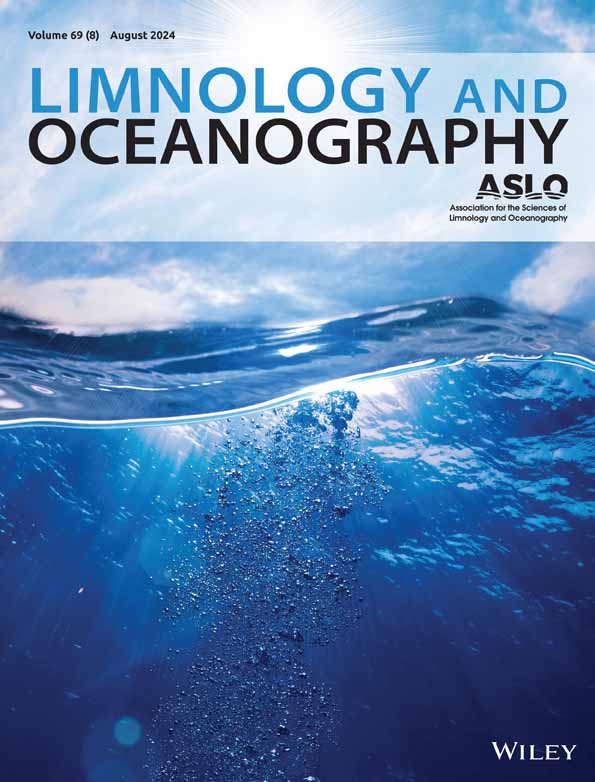西北太平洋热带和亚热带浮游动物功能特征和多样性的垂直变化
IF 3.8
1区 地球科学
Q1 LIMNOLOGY
引用次数: 0
摘要
浮游动物在海洋生物泵中起着举足轻重的作用,其功能性状组成和功能多样性的垂直变化会影响有机碳的输出。然而,我们对西北太平洋浮游动物功能性状和功能多样性的垂直变化认识不足。研究了西北太平洋热带和亚热带浮游动物功能性状组成、功能多样性和性状空间的垂直分布特征。浮游动物功能性状组成呈现明显的垂直变异。主动摄食的浮游动物比例随着深度的增加而增加,而伏击摄食的比例则减少。随着深度的增加,浮游动物的营养类群由杂食性-草食性向杂食性-食腐性转变。浮游动物在0 ~ 100 m层表现出较高的功能丰富度和功能分散性,而在500 ~ 3000 m层表现出较窄的特征空间和较高的功能均匀性。500 ~ 3000 m层浮游动物性状空间嵌套在上层浮游动物性状空间内,表明核心功能结构得到了维持。0 ~ 100 m和500 ~ 3000 m层浮游动物群落聚集主要受环境过滤和限制相似性的影响,其他层浮游动物群落聚集的随机性较大。这些发现强调了浮游动物功能性状与生物泵之间的关系,有助于解释海洋生态系统中生物泵强度的变化。本文章由计算机程序翻译,如有差异,请以英文原文为准。
Vertical variations of zooplankton functional traits and diversity in the tropical and subtropical northwestern Pacific
Zooplankton play a pivotal role in the marine biological pump, and vertical variations in their functional trait composition and functional diversity can affect the export of organic carbon. However, our comprehension of the vertical variations in functional traits and functional diversity of zooplankton in the northwestern Pacific is insufficient. This study examined the vertical distributions in the functional trait composition, functional diversity, and trait space of zooplankton in the tropical and subtropical northwestern Pacific. Zooplankton functional trait composition exhibited obvious vertical variations. The proportion of active‐feeding zooplankton increased with depth, while the proportion of ambush feeders decreased. The trophic groups of zooplankton shifted from omnivore–herbivore to omnivore–detritivore with depth. Zooplankton displayed high functional richness and functional dispersion in the 0–100 m layer, whereas narrow trait space but high functional evenness was observed in the 500–3000 m layer. The trait space of zooplankton within the 500–3000 m layer was nested within that of the epipelagic zone, indicating maintenance of the core functional structure. Environmental filtering and limiting similarity primarily governed zooplankton community assembly in the 0–100 m and 500–3000 m layers, whereas the process was more stochastic in other layers. These findings highlight the relationship between zooplankton functional traits and the biological pump, which could help explain the variations in biological pump strength among marine ecosystems.
求助全文
通过发布文献求助,成功后即可免费获取论文全文。
去求助
来源期刊

Limnology and Oceanography
地学-海洋学
CiteScore
8.80
自引率
6.70%
发文量
254
审稿时长
3 months
期刊介绍:
Limnology and Oceanography (L&O; print ISSN 0024-3590, online ISSN 1939-5590) publishes original articles, including scholarly reviews, about all aspects of limnology and oceanography. The journal''s unifying theme is the understanding of aquatic systems. Submissions are judged on the originality of their data, interpretations, and ideas, and on the degree to which they can be generalized beyond the particular aquatic system examined. Laboratory and modeling studies must demonstrate relevance to field environments; typically this means that they are bolstered by substantial "real-world" data. Few purely theoretical or purely empirical papers are accepted for review.
 求助内容:
求助内容: 应助结果提醒方式:
应助结果提醒方式:


